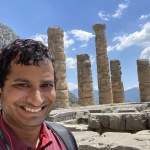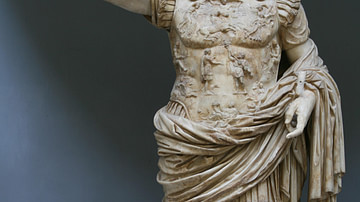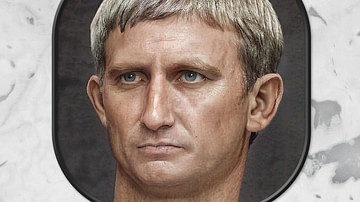Review

| Rating: | |
|---|---|
| Title: | Domitian’s Rome and the Augustan Legacy |
| Author: | Raymond Marks & Marcello Mogetta |
| Audience: | Professional |
| Difficulty: | Hard |
| Publisher: | University of Michigan Press |
| Published: | 2021 |
| Pages: | 330 |
The Roman Emperor Domitian has been condemned by history. However, certain scholars argue his misdeeds do not tell the whole truth. This book shows how Domitian emulated the legacy of Caesar Augustus during his reign through monuments, poetry, and artistic design. With various essays by different authors, editors Raymond Marks and Marcello Mogetta give readers a new insight into this famous Flavian emperor and argue that Augustus' legacy lived on centuries after his death.
The Flavian dynasty has often been portrayed in a positive light except for its final emperor, Domitian. The legacy of Emperor Augustus, according to Marks and Mogetta, was evident during the Flavian rule of Rome. “Vespasian’s other son, Domitian, not only perpetuated the ‘Augustanizing’ programs of his father and brother but greatly expanded them, making the Augustan legacy a centerpiece of his administration and imperial culture” (2). It is the purpose of this book to further show how Augustus’ legacy lived on after his death, even during the reign of one of Rome’s worst emperors. The target audience is both scholars and enthusiasts alike. It succeeds in its goal by offering new research on Domitian and Augustus’ reception in the Roman Empire.
Part One focuses on space in a topographical sense. “Urban Narratives” examines a building and restoration program that incorporated Augustan-like features and became an enduring part of Rome’s urban landscape. The three authors here draw attention to the ambivalent aspect of Domitian’s use of the Augustan legacy. In the opening chapter, the author explains how Domitian’s building programs in the Campus Martius and the Forum Romanum reflect Domitian’s desire not only to emulate Augustus but also to surpass him.
Part Two, ‘Gods and Models’, we explore the nature of the fictitious relationship between Hercules and Domitian. The emperor is seen as superior to the mythological hero, similar to Augustus in portrayal. The authors also explore Domitian’s relationship to his patron deity, Minerva as shown on the surviving strip of the Forum Transitorium, comparing Ovid’s depiction of Arachne’s punishment and Martial’s depiction of her.
Part Three, ‘From Nero to Augustus’, examines the Flavian attempt to connect Domitian with Augustus by distinguishing him from Emperor Nero. The authors point out that Nero’s adoption of Augustus’ legacy created a fragile situation for Flavian poets when they compare Domitian with Augustus. This is a comparison of ancient sources such as Calpirnius Siculus, Silius Italicus, and Lucan.
Part Four, ‘Poetic Journeys’, deals with the theme of space in poetry each examining the treatment of Augustan texts by a poet in the time of Domitian. Once again, this is a comparison of sources, like Statius, Silius Italicus, and Virgil. They examine how various poems depict heroic achievements, comparing them to Augustus and Domitian. They are challenging the old Augustan depictions and showing that newer interpretations by Domitian’s reign are more up-to-date. Associating Domitian with these various mythological figures was part of the Roman Imperial cult, maintaining the idea that the emperor upholds a divine status.
Part Five, ‘History and Reception’, discusses major historical features in Domitain’s reign stemming from Augustus. The author implies that Domitian initiated legislation in 88 CE, prohibiting senators from accepting freedmen and giving them freeborn status. Domitian feared this would impede his promotion of loyal men to senator. The last chapter discusses how Domitian’s successor Nerva induced via coins and other material ideas of renewal and rebirth. This was to differentiate him from Domitian.
Both editors are professors at the University of Missouri's Department of Classics, Archaeology, and Religion. This book tries to argue that despite Domitain’s “damnatio memoriae,” he improved Augustus’ legacy (12). Throughout this work, the different authors have ambivalent perceptions of Domitian’s approach to the Augustan legacy and the writers of his time’s assessment of him as emperor. Marks and Mogetta have produced a complex assessment of this multi-faceted topic. It is not an easy read, because the target audience consists of scholars and students of classics. It contains various translated Greek and Latin texts, and photographs of coins and monuments that illustrate their points. This book is highly recommended, though it can be a challenging read.
Cite This Work
APA Style
Mathew, P. (2025, January 20). Domitian’s Rome and the Augustan Legacy. World History Encyclopedia. Retrieved from https://www.worldhistory.org/review/502/domitians-rome-and-the-augustan-legacy/
Chicago Style
Mathew, Philip. "Domitian’s Rome and the Augustan Legacy." World History Encyclopedia. Last modified January 20, 2025. https://www.worldhistory.org/review/502/domitians-rome-and-the-augustan-legacy/.
MLA Style
Mathew, Philip. "Domitian’s Rome and the Augustan Legacy." World History Encyclopedia. World History Encyclopedia, 20 Jan 2025, https://www.worldhistory.org/review/502/domitians-rome-and-the-augustan-legacy/. Web. 20 Apr 2025.




